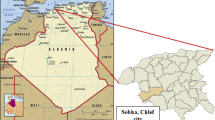Abstract
It is well known that the specimen preparation method and the resulting sand fabric significantly affect sand behavior and sand liquefaction resistance. In many cases, the fabric and behavior of reconstituted sand samples do not represent those of in-situ deposits. Therefore, understanding the influence of specimen preparation and sand fabric on its behavior, particularly at the critical state, is important for relating the behavior of laboratory reconstituted specimens to in-situ soil response. In this study, the effect of sand fabric and specimen preparation method on the shearing behavior of sand is studied using triaxial shear tests. Dry funnel pluviation (DFP) and wet tamping (WT) are used to prepare the specimens. The results from instability lines and stress–strain curves indicate that the liquefaction resistance of specimens prepared with the DFP method is more than specimens reconstituted by the WT method.
Similar content being viewed by others
References
Vaid P.Y., Sivathayalan S., Stedman D.: Influence of specimen reconstituting method on the undrained response of sand. Geotech. Test. J. 22, 187–195 (1999)
Ishihara K.: Liquefaction and flow failure during earthquakes. Geotechnique 43, 351–415 (1993)
Wood, F.M., Yamamuro, J.A.: The effect of depositional method on the liquefaction behavior of silty sand. In: Proceedings 13th ASCE Engineering Mechanics Conference. The Johns Hopkins University, Baltimore, MD; CD-ROM (1999)
Benahmed N., Canou J.J., Dupla J.C.: Structure initiale et propriétés de liquéfaction statique d’un sable. Comptes Rendus Mécanique 332, 887–894 (2004)
Wood F.M., Yamamuro J.A., Lade P.V.: Effect of depositional method on the undrained response of silty sand. Can. Geotech. J. 45, 1525–1537 (2008)
Yamamuro J.A., Wood F.M., Lade P.V.: Effect of depositional method on the microstructure of silty sand. Can. Geotech. J. 45, 1538–1555 (2008)
Della N., Arab A., Belkhatir M.: Effect of confining pressure and depositional method on the undrained response of medium dense sand. J. Iber. Geol. 37, 37–44 (2011)
Kuerbis R., Vaid Y.P.: Sand sample preparation—the slurry deposition method. Soils Found 28, 107–118 (1988)
Kramer S.L., Seed H.B.: Initiation of soil liquefaction under static loading conditions. J. Geotech. Eng. 114, 412–430 (1988)
Papadimitriou A.G., Dafalias Y.F., Yoshimine M.: Plasticity modeling of the effect of sample preparation method on sand response. Soils Found. 45, 109–123 (2005)
Wood, F.M.: Influence of specimen reconstitution method on the undrained response and microstructure of silty sand. Thesis completed in partial fulfillment of the requirements for the degree of Master of Science, Department of Civil and Environmental Engineering, Clarkson University (1999)
Yamamuro J.A., Lade P.V.: Static liquefaction of very loose sands. Can. Geotech. J. 34, 905–917 (1997)
Della N., Arab A., Belkhatir M., Missoum H.: Identification of the behaviour of the Chlef sand to static liquefaction. C. R. Mechanique 337, 282–290 (2009)
Yoshimine M., Robertson P.K., Wride C.E.: Undrained shear strength of clean sands to trigger flow liquefaction. Can. Geotech. J. 36, 891–906 (1999)
Castro, G.: Liquefaction of sands. Ph.D. thesis, Harvard University, Cambridge, MA (1969)
Kramer S.L.: Geothechnical Earthquake Engineering, pp. 653. Prentice Hall, NJ (1996)
Leong W.K., Chu J., Teh C.I.: Liquefaction and instability of a granular fill material. Geotech. Test. J 23, 178–192 (2000)
Lade, P.V.: Instability of granular materials. In: Lade, P.V., Yamamuro, J.A. (eds.) Physics and mechanics of soil liquefaction, pp. 3–16. Balkema, Rotterdam (1999)
National Research Council: Liquefaction of soils during earthquakes. National Academy Press, Washington, DC (1985)
Lade P.V.: Static instability and liquefaction of loose sandy slopes. J Geotech Eng 118, 51–71 (1992)
Lade P.V.: Initiation of static instability in the submarine Nerlerk berm. Can Geotech J 30, 895–904 (1993)
Olson S.M., Stark T.D., Walton W.H., Castro G.: 1907 Static liquefaction flow failure of the north dike of wachusett dam. J Geotech Geoenviron Eng 126, 1184–1193 (2000)
Chu J., Leong W.K.: Effects of lines on instability behaviour of loose sand. Geotechnique 52, 751–755 (2002)
Author information
Authors and Affiliations
Corresponding author
Rights and permissions
About this article
Cite this article
Della, N., Belkhatir, M., Arab, A. et al. Effect of fabric method on instability behavior of granular material. Acta Mech 225, 2043–2057 (2014). https://doi.org/10.1007/s00707-013-1083-z
Received:
Revised:
Published:
Issue Date:
DOI: https://doi.org/10.1007/s00707-013-1083-z




